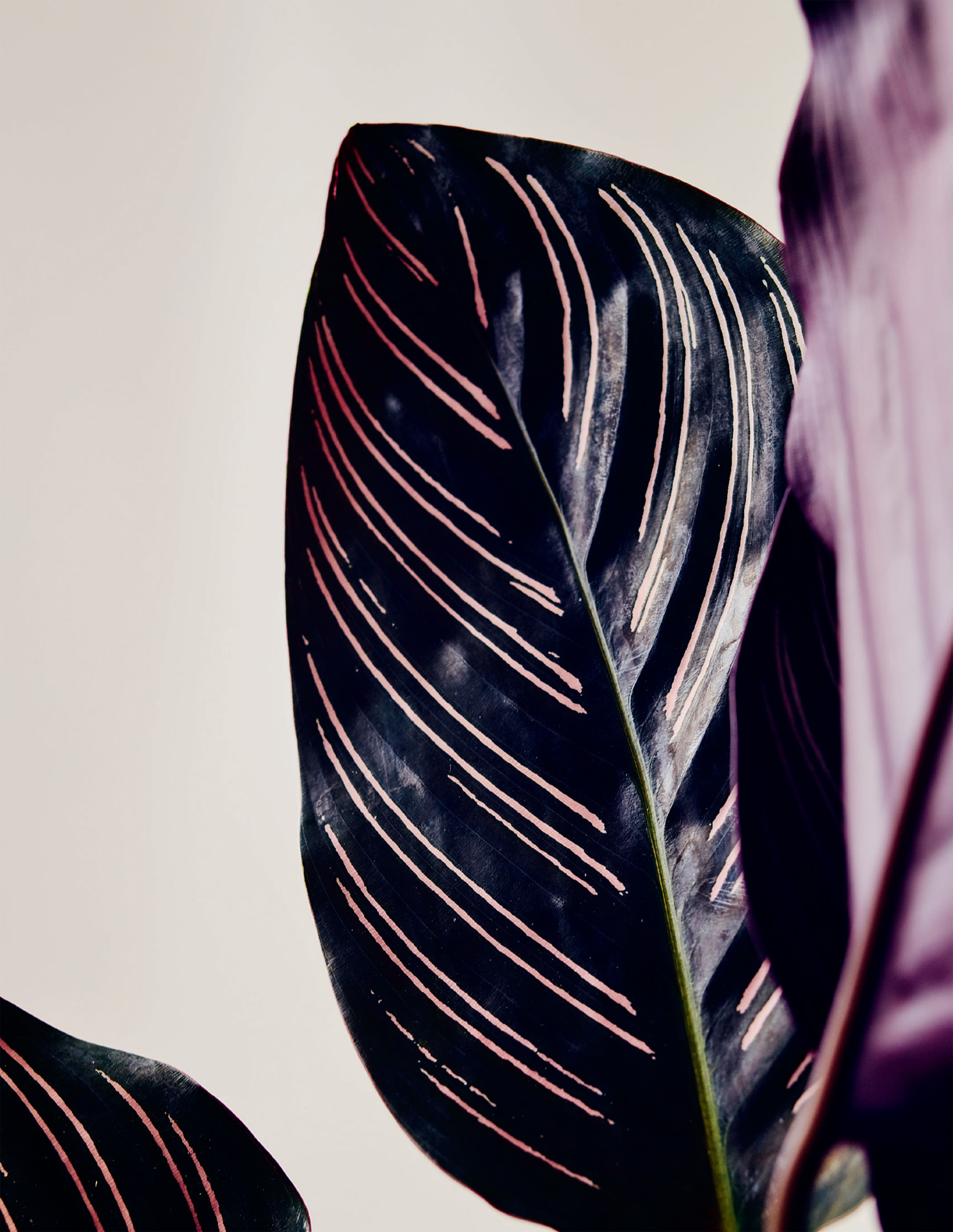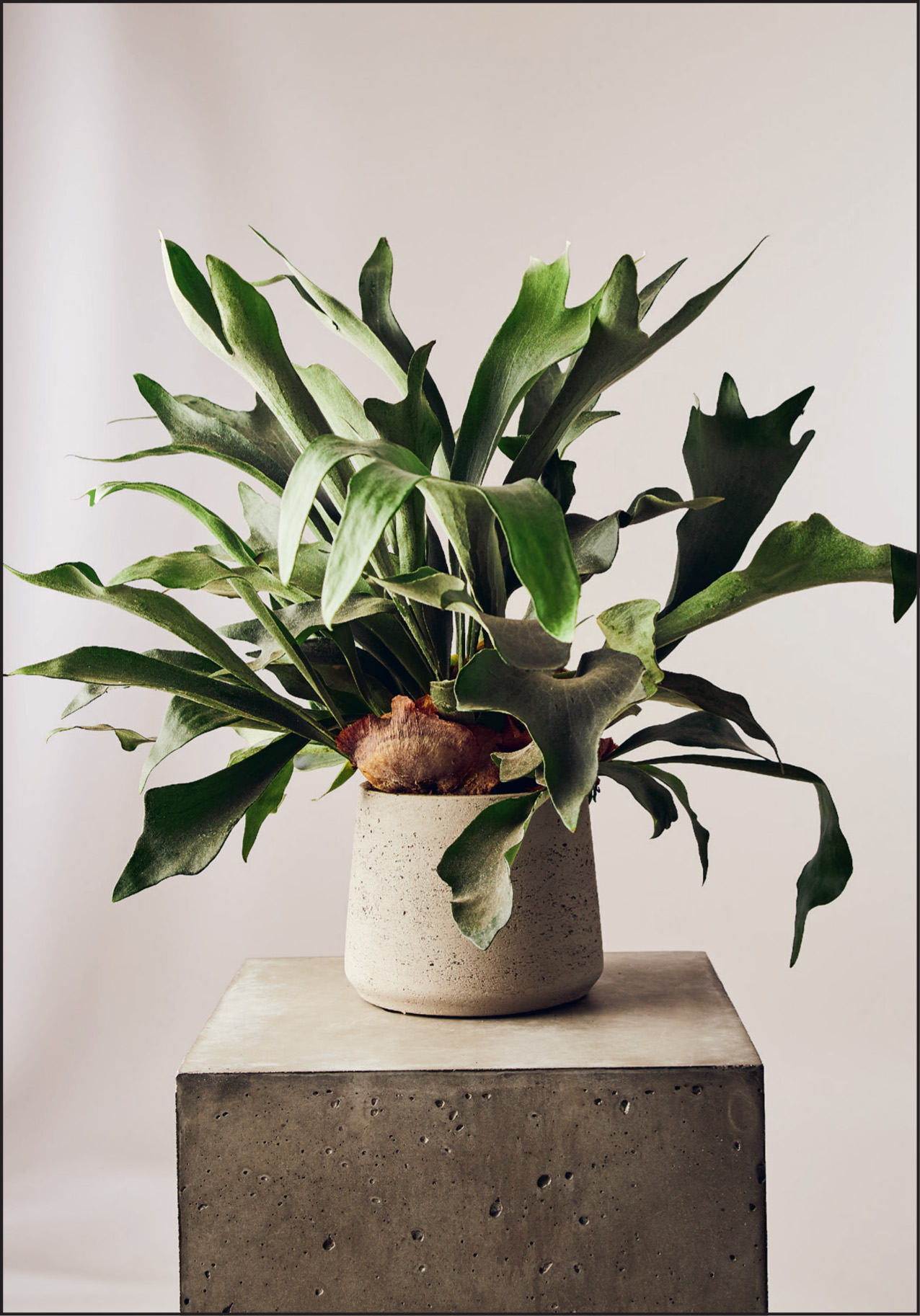


THE HEALING POWER OF PLANTS
The hero house plants that will love you back
FRAN BAILEY

Plants
for calm
and
relaxation
Well-placed plants give a relaxing, restful ambience to any room, and by bringing nature into your home you are helping to create a calmer and more grounded environment. Constantly seeing and being around plants, and even just looking at the colour green, helps us to feel calmer and ready for whatever life throws at us.

ROSE GRAPE AND STAGHORN FERN
PIN-STRIPE CALATHEA
CALATHEA ORNATA
 LIGHT Prefers a shadier position out of bright light, which may scorch the leaves. Look closely and you may notice how the leaves move position to adapt to the light conditions.
LIGHT Prefers a shadier position out of bright light, which may scorch the leaves. Look closely and you may notice how the leaves move position to adapt to the light conditions.
 HUMIDITY Loves high humidity so group Calathea with other plants to create a humid microclimate, or sit the pot in a tray of damp pebbles.
HUMIDITY Loves high humidity so group Calathea with other plants to create a humid microclimate, or sit the pot in a tray of damp pebbles.
 WATERING Water thoroughly so the compost is fully soaked and then allow to dry out between watering. If the plant is very thirsty it will roll up its leaves.
WATERING Water thoroughly so the compost is fully soaked and then allow to dry out between watering. If the plant is very thirsty it will roll up its leaves.
 CARE Calathea is the ideal candidate for brightening up that dingy corner in your living room but will be unhappy if put in a draught. For a healthy plant, feed with half-strength plant food every two weeks throughout the summer season and keep in a warm spot with temperatures above 16c.
CARE Calathea is the ideal candidate for brightening up that dingy corner in your living room but will be unhappy if put in a draught. For a healthy plant, feed with half-strength plant food every two weeks throughout the summer season and keep in a warm spot with temperatures above 16c.
Queen of the forest floor, this extraordinarily beautiful plant really deserves its popularity. This is not a plant for beginners, but given the right conditions it will thrive and can be long-lived. You will also find that the gentle grace of this plant brings a sense of calm to the room. The pink-striped leaves look hand-painted while the deep plum-coloured underside allows the plant to absorb low light. The key to keeping this beauty flourishing is to provide warmth, humidity and filtered light just as though it were at home in the Amazonian rainforest.

PIN-STRIPE CALATHEA
STAGHORN FERN
PLATYCERIUM BIFURCATUM
 LIGHT Unlike most other ferns the Staghorn prefers bright but indirect light.
LIGHT Unlike most other ferns the Staghorn prefers bright but indirect light.
 HUMIDITY This fern absorbs water through its fronds so responds well to regular misting and high humidity. Mist throughout cooler months, particularly if the central heating is on. A bathroom with sufficient light and ambient humidity is a perfect spot.
HUMIDITY This fern absorbs water through its fronds so responds well to regular misting and high humidity. Mist throughout cooler months, particularly if the central heating is on. A bathroom with sufficient light and ambient humidity is a perfect spot.
 WATERING Frequency will depend on the heat and humidity levels. Feel behind the low oval-shaped leaves at the base of the plant and if dry submerge the plant in water for a few minutes. Allow compost to dry out between watering overwatering may rot the plant.
WATERING Frequency will depend on the heat and humidity levels. Feel behind the low oval-shaped leaves at the base of the plant and if dry submerge the plant in water for a few minutes. Allow compost to dry out between watering overwatering may rot the plant.
 CARE When repotting, use orchid compost or chipped bark. The smaller, round base fronds turn brown with age: this does not mean that the plant is dying. Any dried shield fronds should not be removed.
CARE When repotting, use orchid compost or chipped bark. The smaller, round base fronds turn brown with age: this does not mean that the plant is dying. Any dried shield fronds should not be removed.
The mighty Staghorn is an elegant beast and can make a great houseplant given the right care and attention. The key to success is an understanding of how it grows in its native habitat the tropics. Like an orchid or air plant, the Staghorn is an epiphyte, attaching itself to the bark of the host tree with its small roots, then absorbing nutrients and water through its green, antler-like fronds. In the wild, the Staghorn can grow to truly epic proportions, cascading from the crook of a tree high up in the forest canopy.
You may have seen these plants mounted on bark pieces a way of replicating their native forest habitat and this is the ideal way to grow them at home. They can be grown in pots but their beauty really shines when they are displayed in a hanging basket as a stand-alone specimen. This allows their hanging fronds to cast shadows against the wall, creating a sense of peace and calm.

STAGHORN FERN
ASPARAGUS FERN
ASPARAGUS SETACEUS
 LIGHT Prefers bright but indirect light. If the light levels are too low the needles will yellow and drop; too bright and the foliage will scorch.
LIGHT Prefers bright but indirect light. If the light levels are too low the needles will yellow and drop; too bright and the foliage will scorch.
 HUMIDITY Enjoys high humidity.
HUMIDITY Enjoys high humidity.
 WATERING Water regularly during the growing season between spring and autumn; reduce in the winter.
WATERING Water regularly during the growing season between spring and autumn; reduce in the winter.
 CARE Keep away from radiators in the winter. When the central heating is on humidity levels may drop, so regular misting will keep your plant happy.
CARE Keep away from radiators in the winter. When the central heating is on humidity levels may drop, so regular misting will keep your plant happy.
The gentle grace of this plant will aid relaxation when you retreat to the sanctuary of your plant-filled room. Although related to culinary asparagus, it is not edible, nor is it really a fern, so the name of this delicate plant is a little confusing. In the wild this plant is a climber, using the small spines on its stem to scramble up a larger, neighbouring plant. As the fern matures its bushy habit changes, and the feathery fronds become extended and more tendril-like.

ASPARAGUS FERN
RABBIT-FOOT FERN
PHLEBODIUM AUREUM
 LIGHT Prefers mid- to lower light levels but can tolerate bright indirect light if the temperature remains cool. Direct light will scorch the leaves.
LIGHT Prefers mid- to lower light levels but can tolerate bright indirect light if the temperature remains cool. Direct light will scorch the leaves.
 HUMIDITY Loves high humidity, so regular misting is beneficial.
HUMIDITY Loves high humidity, so regular misting is beneficial.
 WATERING Water regularly but moderately: the fern will not tolerate being waterlogged. Make sure excess water can drain away to prevent rotting of the roots and stems.
WATERING Water regularly but moderately: the fern will not tolerate being waterlogged. Make sure excess water can drain away to prevent rotting of the roots and stems.

Next page













 ROSE GRAPE AND STAGHORN FERN
ROSE GRAPE AND STAGHORN FERN  LIGHT Prefers a shadier position out of bright light, which may scorch the leaves. Look closely and you may notice how the leaves move position to adapt to the light conditions.
LIGHT Prefers a shadier position out of bright light, which may scorch the leaves. Look closely and you may notice how the leaves move position to adapt to the light conditions. HUMIDITY Loves high humidity so group Calathea with other plants to create a humid microclimate, or sit the pot in a tray of damp pebbles.
HUMIDITY Loves high humidity so group Calathea with other plants to create a humid microclimate, or sit the pot in a tray of damp pebbles. WATERING Water thoroughly so the compost is fully soaked and then allow to dry out between watering. If the plant is very thirsty it will roll up its leaves.
WATERING Water thoroughly so the compost is fully soaked and then allow to dry out between watering. If the plant is very thirsty it will roll up its leaves. CARE Calathea is the ideal candidate for brightening up that dingy corner in your living room but will be unhappy if put in a draught. For a healthy plant, feed with half-strength plant food every two weeks throughout the summer season and keep in a warm spot with temperatures above 16c.
CARE Calathea is the ideal candidate for brightening up that dingy corner in your living room but will be unhappy if put in a draught. For a healthy plant, feed with half-strength plant food every two weeks throughout the summer season and keep in a warm spot with temperatures above 16c. PIN-STRIPE CALATHEA
PIN-STRIPE CALATHEA  STAGHORN FERN
STAGHORN FERN  ASPARAGUS FERN
ASPARAGUS FERN